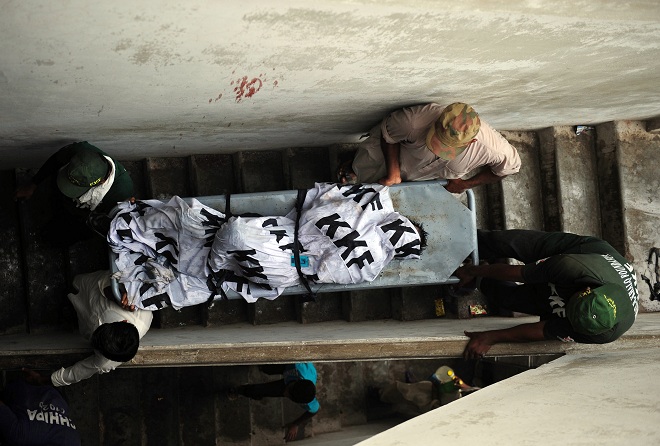
AFP PHOTO / ASIF HASSAN
Fire swept through two factories in Pakistan, in Karachi and Lahore on Tuesday night, claiming hundreds of lives in one of the deadliest nights in the country, Reuters reported.
The latest toll suggests at least 314 dead, according to Reuters, due to a blaze that devoured a garment factory in the southern industrial city of Karachi, and a shoe factory in Lahore, Pakistan’s largest city.
“The owners were more concerned with safeguarding the garments in the factory than the workers,” garment factory employee Mohammad Pervez told Reuters. Pervez held a photo of his missing cousin, who is also a factory worker.
The Karachi factory fire was more deadly killing more than 289 people most of whom suffocated as they were trapped in the burning building.
“We found people who died because of suffocation caused by the highly toxic smoke. They died first and then their bodies were burned by the raging fire,” Karachi fire chief Ehtesham Salim told BBC.
He also added that there were no fire exits, most workers were trapped in the basement whose doors were locked.
“There were no safety measures taken in the building design. There was no emergency exit. All the people got trapped,” senior police official Amjad Farooqi told AP.
He added that the police are searching for the factory owners, while the senior government official in Karachi said authorities have placed their names on a travel ban list.
As the fire raged, the only way to escape was to jump off the windows that were covered with steal grilles. Officials said that clothes, chemicals and other flammable materials were piled inside the five-storey building
“I jumped from my seat as did others and rushed toward the windows, but iron bars on the windows barred us from escaping. Some of us quickly took tools and machines to break the iron bars,” said Mohammad Ilyas, a factory worker, speaking to AP from the hospital “That was how we managed to jump out of the windows down to the ground floor.”
Ilyas and many other workers, including a 27 year-old pregnant woman, suffered injuries and broken bones as they fell from the windows.
“Some bodies are completely charred and cannot be recognised,” Karachi official Mohamed Hussain Syed told BBC. “It is only possible [to identify them] through DNA tests. It was a big garment factory where lots of people were working. That’s why it is difficult to assess how many have come out safely and how many failed to escape and were trapped.”
In the eastern city of Lahore, fire raged through a four-storey shoe factory, Tuesday night, killing at least 25 people.
“We saw our colleagues burning alive, in flames,” Shabdir Hussain told Reuters from his hospital bed. “We could do nothing. We saved our lives by jumping from the roof.”
The illegally built shoe factory caught fire when workers tried to start the electricity generator during a power cut, a common occurrence throughout Pakistan, reported AP.
Sparks from the generator touched the chemicals used in shoe manufacturing and started the fire that claimed the life of many workers.
Mohamed Shabbir, a worker told AP that the chemicals and the generator are located in the garage, which was the only way out of the factory and thus when the fire started there was no way to escape. “The people went to the back side of the building but there was no access, so we had to make forceful entries and … rescue the people,” Numan Noor, a fire-fighter at the scene told AP.
Fire-fighters had to break through the walls, to reach the workers trapped inside the building.
Bodies from the two factories were taken to different hospitals amid concerns that more bodies were still inside. Dead, charred bodies lined the morgue’s floor covered with white sheets.
In response, the Pakistani Prime minister Raja Pervaiz Ashraf expressed his shock and grief over the deaths in Karachi and Lahore, while a provincial minister ordered inspection of all the factories and industrial plants in the Sindh province, where Karachi is located, within 48 hours, reported Reuters.
The tragedy fuelled public anger against the government and provoked calls for industrial safety measures that are generally overlooked in the country.

